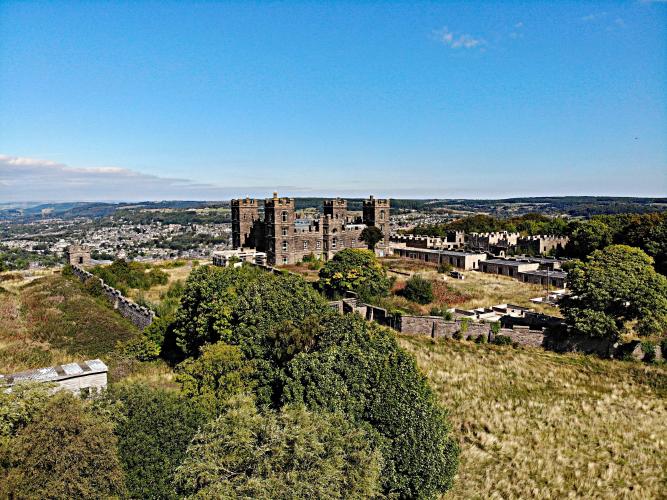![Cycling Riber, England Cycling Riber, England - aerial drone view of Riber castle and the surrounding grounds, town in background, Simon Warren's 100 Greatest Cycling Climbs #32 logo in corner]()
Riber Castle near top of climb (privately owned - no tours). . . but . . .
![]()
. . .the drone has the keys to the castle!
Riber Hill hosted the British National Hill Climb Championships in 1986 (Darryl Webster wins his fourth consecutive championship and final of his career this year).
![Cycling Riber, England Cycling Riber, England - photo collage, road signs warning 22% grade, road unsuitable for long vehicles, road unsuitable for motors, bike leaning against wall in front of road sign, view from afar of Riber castle, view looking up the hill on a one-lane road, PJAMM Cycling logo in corner]()
Short at 1.1 kilometers but steep at 10.5% average grade! The first half of this route is through a residential suburb just south of the town of Matlock in the southeastern edge of the Peak District National Park.
Just over halfway up the climb we are confronted with a sign that states “Unsuitable for motors” + 25% gradde. This sign gives good advice as there is a stretch of 200 meters a bit past this sign that averages a brutal 18% average grade.
![Cycling Riber, England Cycling Riber, England - road sign for Riber Road against a brick wall partially covered in greenery, next to that a second road sign stating "Unsuitable for long vehicles, 22% grade, windy road for 1/4 mile"]()
Can’t say you weren’t warned . . .
Upon leaving the residential area we are in the forest for the last 200 meters to the top of the climb.
![Cycling Riber, England Cycling Riber, England - view 50 meters from climb finish, one-lane road surrounded by thick vegetation, road sign for 22% grade, unsuitable for long vehicles]()
50 meters from Finish.
Stay on Riber Road for another 500 meters to the gate blocking your way into the amazing Riber Castle. The castle is privately owned but just amazing -- we buzzed it a couple times with our drone and got some great photos and videos you can see on our Climb Page.
![Cycling Riber, England Cycling Riber, England - photo collage, aerial view of Riber Castle, signs noting it is a private residence, gate closing off entrance, PJAMM Cycling logo in corner]()
![]()
Steepest ½ kilometer begins at km 600m (15%).
Cycling Uphill writes of this climb:
“Riber is a ‘popular’ hill climb to the south of Matlock. It has everything you can want in a classic steep British hill climb. A maximum gradient of 25% – two very hard corners and then a longer drag to the castle” (More).
History of Riber Castle:
“Riber Castle is a 19th-century Grade II listed country house in the hamlet of Riber on a hill overlooking Matlock, Derbyshire. Known locally as "Smedley's Folly" because of the difficulty of getting water to the hill summit, it was built by the industrialist John Smedley in 1862 as his private home. His wife lived in it until her death.
It is built of gritstone from a local quarry (Derbyshire is well known for its quarrying) which was pulled up the 200-metre (660 ft) hill by a series of pulleys.
After the death of Smedley's wife, the castle became a boys' school until this became financially unsustainable in the 1930s. With the coming of World War II the Ministry of Defence used the site for storage. The MoD left following the war and the castle remained unused until the 1960s.
From the 1960s to September 2000 it was home to a wildlife park, containing British and European fauna. Riber Castle Wildlife Park, or Riber Zoo as it was known, was eventually sold by the owner, but they were unable to sell it as a going concern, and so the park eventually closed. The park was criticised heavily for the treatment of the animals kept there, and the closure was not without controversy. Activists also released several lynx from Riber Zoo which escaped into the wild.
Plans to turn the shell into apartments received planning consent on 15 March 2006. The castle walls have now been secured, chimneys and floors rebuilt, 119 windows replaced and a roof added. It is expected that two show apartments will be ready some time in 2014. Access to the site before 2006 was securely restricted, until the perimeter fence was unwired to provide unrestricted access to the site, which later became a commonly used footpath. However, recently developers have added a second (more secure) fence, boarded up all entrance points and have manned security onsite. More recently, the castle has been converted into flats.
The castle and the town of Matlock are key locations in the Shane Meadows film Dead Man's Shoes” (Riber Castle).

 We've partnered with Sherpa-Map.com to bring you the best route planning tool. With a PRO Membership you can use this climb as a reference when creating your route.
We've partnered with Sherpa-Map.com to bring you the best route planning tool. With a PRO Membership you can use this climb as a reference when creating your route. 

